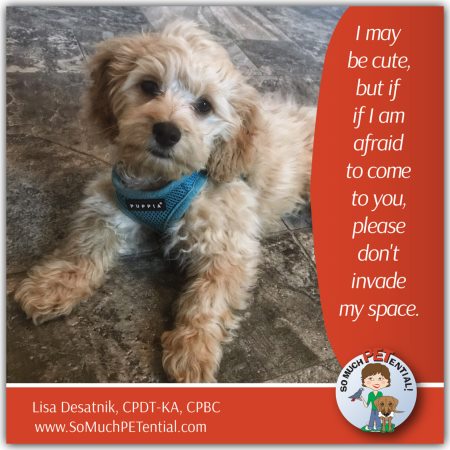When dog lovers meet a puppy as adorable as this little boy, often their reaction is to try and move into his space, reach for or pet him, or even try to pick him up.
However, on the day that I first met Willie, he huddled next to his human sister on the couch when I walked into the room. When she walked out and it was only Willie’s human dad, me and him in the room, Willie stayed under his dad’s chair while we talked. I then sat on the ground across the room – high value treats on a table not far from me – to observe the four-month old’s body language. Willie continued to stay at his dad’s side. When I threw a treat a few feet from them, Willie walked to get it with his tail down, keeping his eye on that stranger who tossed it, and then immediately moved back to his dad. I did this a few times.

Within a few minutes, the little boy began coming closer to me; however, he was ready to move backwards in an instant. And he did move back to his dad several times before coming all the way toward me. I did not have a treat in my hand to lure him to me, but when he did come, I got a treat from the table and gave it to him and spoke in a calm voice, but otherwise remained still, not making any attempt to reach for or interact with him in any other way.
Within a few more minutes, I knew Willie was feeling safe around me because he was choosing to stay with me instead of moving back to his dad and his body muscles were loose. He began actively engaging with me. Only as I saw him continuing to stay with me and even soliciting attention did I begin touching him, even playing with him.
Had I ignored Willie telling me through his body language and distance in the beginning, walked into his space, and forced physical interaction with me, I could have potentially heightened his fear reaction. I could have taught Willie that his ‘safe spot’ really was not safe at all, and that non-aggressive dog signals do not work to get some people to stay away. It most definitely would not have helped (at least without first causing him a lot of stress) him to learn that I was actually a pretty fun person to hang out with.
Willie’s movement toward me is called approach avoidance conflict in dogs.
When a dog is experiencing this, it may move toward something but is also ready to move away quickly. It may show other body language to communicate discomfort such as stiff body muscles; either hyper vigilance, a direct stare, or quick glances; low tail; body shake off; sniffing; excessive panting; or barking or whining.
This can happen when there is something alluring about that stimulus to cause the dog to get closer; however, at the same time, the fact is, the dog is getting closer to something it is unsure about. If, when a dog experiences this, anything negative happens (from the dog’s perspective), then the dog may be less likely to approach other similar stimulus in the future and may show more of that body language. If, however, something positive happens, then the dog may be more likely to approach that stimulus in the future
This is one reason why it is often not the best approach to have strangers (for whom the dog is afraid) to lure the fearful dog toward them. When the food runs out and the dog realizes it is way too close for comfort, it may erupt into barking, lunging, moving away or worse.
Instead, those strangers can toss food away from them so that the dog gets two reinforcers – distance and good food. When there is conflict, allowing the dog to work through it while ensuring nothing bad happens to the dog as it approaches (only good things), will help to teach the dog a different association with that stimulus.
In Willie’s case, after about 15 minutes, we walked into the other room. Willie followed right along with his tail wagging and his muscles continued loose. He never moved away from me again during that visit, and, on my second visit, his tail was wagging when he saw me enter the room.
I wanted to share this experience as I have seen many puppies (and adult dogs) exhibit this kind of conflict with unfamiliar people, things or environment. Puppies too will have fear episodes where stimulus suddenly become scary to them. I’ve experienced this first hand with my Dawson (I’ll save this for another future blog post).







